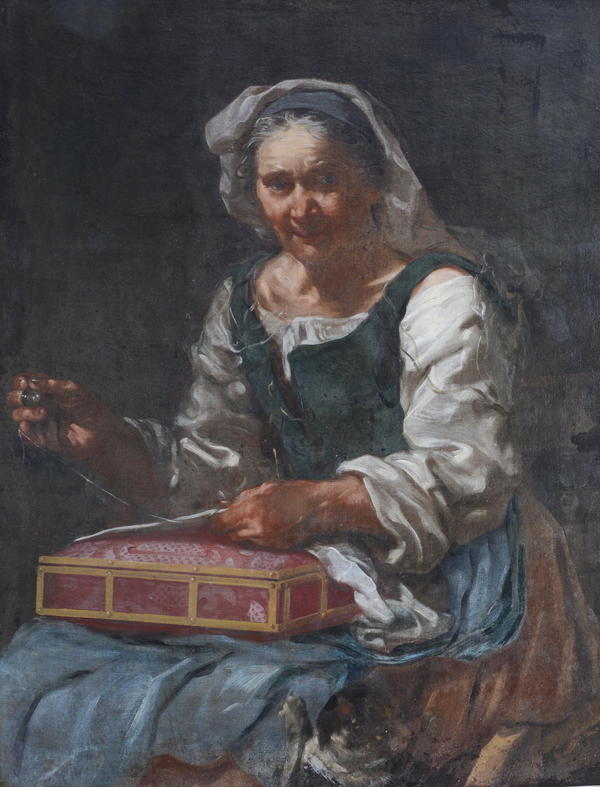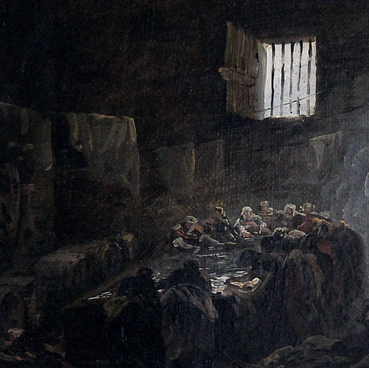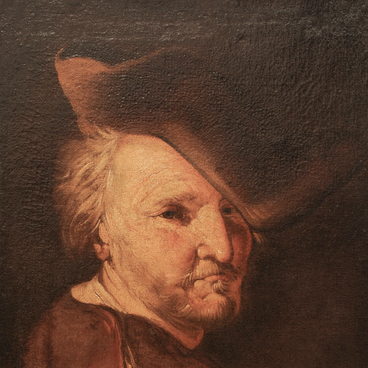Eberhard Keil, nicknamed ‘Monsu Bernardo’ or ‘Monsieur Bernardo’, was a genre and portrait painter. He was born in the city of Helsingør in Northeast Denmark. His father worked as a painter in the court of Christian IV, King of Denmark.
At the age of 12, Keil started studying painting at the studio of Danish artist Maarten van Steenwinckel in Copenhagen. At the age of 18, he moved to Amsterdam and continued his studies with Rembrandt Harmenszoon van Rijn.
The artist probably lived for some time in France, what is evidenced by his nickname. In 1651, he came to Italy. There, he worked first in Venice, then Bergamo and Milan, and, from 1656 to the end of his life, in Rome.
Together with Michelangelo Cerquozzi, Keil featured prominently among the ‘pittori della realta’ – ‘painters of reality’. This was a group of artists who worked in Italy and expressed in their works, in a comprehensive and harmonious way, interest for everyday life and social problems at the turn of the 17th and 18th centuries.
Constituting an integral part of the Baroque culture, their art opposed academic canons and decorative and illusionistic painting. While, in the latter, religious, mythological, historical subjects and grand portraits were dominant, the ‘painters of reality’ established in the art of Catholic countries the so called ‘low genres’: scenes from the life of soldiers, peasants, merchants, artists, and tramps.
This piece was ascribed to Eberhard Keil by leading Russian art historian Boris Vipper in 1959.
The impact of the Rembrandt school is definitely traced in the painting, it is evidenced not only by the model choice, but also by the depth of interpretation of the old woman’s image. A playful cat placed in the lower part of the canvas also reminds of the Rembrandt-style environment of home comfort.
However, in the painter’s artistic manner, purely Italian features already prevail: quick, dynamic brushwork and a skillfully composed bouquet of vibrant, vivid colors.
In the art experts’ opinion, it is probable that this canvas of Eberhard Keil is included in his series of paintings dedicated to the subject of the “Five Senses” and is, in this case, an allegory of taction.
Yury Merlin’s collection, and then the Serpukhov Museum Collection, included before a twin canvas by Keil – Old Woman with a Candle. In 1962, it was delivered to the Pushkin State Museum of Fine Arts in exchange for Jan Victors’ painting Street Healer.
At the age of 12, Keil started studying painting at the studio of Danish artist Maarten van Steenwinckel in Copenhagen. At the age of 18, he moved to Amsterdam and continued his studies with Rembrandt Harmenszoon van Rijn.
The artist probably lived for some time in France, what is evidenced by his nickname. In 1651, he came to Italy. There, he worked first in Venice, then Bergamo and Milan, and, from 1656 to the end of his life, in Rome.
Together with Michelangelo Cerquozzi, Keil featured prominently among the ‘pittori della realta’ – ‘painters of reality’. This was a group of artists who worked in Italy and expressed in their works, in a comprehensive and harmonious way, interest for everyday life and social problems at the turn of the 17th and 18th centuries.
Constituting an integral part of the Baroque culture, their art opposed academic canons and decorative and illusionistic painting. While, in the latter, religious, mythological, historical subjects and grand portraits were dominant, the ‘painters of reality’ established in the art of Catholic countries the so called ‘low genres’: scenes from the life of soldiers, peasants, merchants, artists, and tramps.
This piece was ascribed to Eberhard Keil by leading Russian art historian Boris Vipper in 1959.
The impact of the Rembrandt school is definitely traced in the painting, it is evidenced not only by the model choice, but also by the depth of interpretation of the old woman’s image. A playful cat placed in the lower part of the canvas also reminds of the Rembrandt-style environment of home comfort.
However, in the painter’s artistic manner, purely Italian features already prevail: quick, dynamic brushwork and a skillfully composed bouquet of vibrant, vivid colors.
In the art experts’ opinion, it is probable that this canvas of Eberhard Keil is included in his series of paintings dedicated to the subject of the “Five Senses” and is, in this case, an allegory of taction.
Yury Merlin’s collection, and then the Serpukhov Museum Collection, included before a twin canvas by Keil – Old Woman with a Candle. In 1962, it was delivered to the Pushkin State Museum of Fine Arts in exchange for Jan Victors’ painting Street Healer.



